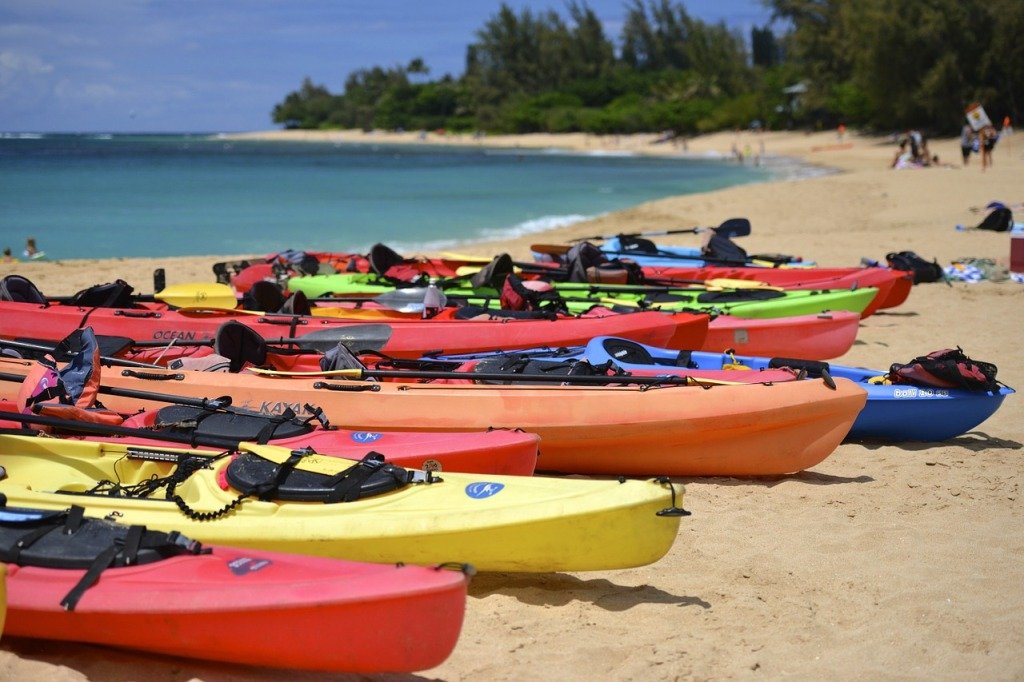Is Kayaking Hard? Here’s What You Need to Know
How to Spend a Relaxing Weekend on the Water
For the longest time, I avoided it.
I remembered those childhood canoe trips, the ones down the narrow rivers with the rocky beds.
The canoe would inevitably snag, Dad would yell profanities, Mom would get frustrated and us kids couldn’t paddle straight to save our lives.
So when, as an adult, my wife told me she wanted to get a kayak, my first thought was probably the same as yours: No way I’m going down that road again.
To no one’s surprise, I lost that argument. And I’m pretty glad I did.
What We’ll Cover in This Guide
- Choosing the Right Kayak
What size kayak do I need?
Which kayak is more stable? - Learning How to Kayak
Kayak paddling techniques
Tandem or single kayak?
Choose the right kayak paddle length - Is Kayaking Safe?
Will I capsize?
What to bring kayaking?
Can I go kayaking alone?
Kayak rescue techniques
How hard is kayaking?
I’ll be the first to admit that kayaking was not as hard as I thought it would be.
Out on the lake by her parents’ house in our very own pair of Lifetime Payette 116 kayaks, I was honestly shocked at how easily I was able to maneuver, paddle and splash around the lake at my own pace.
While I’d like to think my manly 29-year-old muscles had a little to do with my rapid success, I don’t think that would be entirely fair to the little kids and grandmas who were cruising around us with ease.
The fact is, paddling a kayak can be one of the easiest ways to enjoy the water without overtaxing yourself.
And there are several reasons for this.
Here’s how any beginner can get started kayaking and pick up a brand new hobby.

1. Choosing the Right Kayak
The first and most important step to an enjoyable kayaking experience is picking the right kayak for you.
I didn’t have a choice in my first kayak, but it turns out I got lucky. The Payette, at just under 10 feet, is on the smaller side when it comes to kayaks, meaning it was incredibly easy to control right out of the gate.
Check out American Paddler’s guide to choosing the right kayak for you.
What size kayak do I need?
Kayak size is the most important factor for a beginning kayaker to consider.
Yep, that’s right.
Even more than weight, stability or materials used, the length and width of a kayak are the single biggest determining factors in how difficult kayaking will be for a first-timer.
There are a few reasons for this.
For one, the length and width directly impact how difficult the kayak will be to steer and paddle.
For most beginners, a shorter kayak provides greater control and maneuverability. And it makes sense when you think about it: The longer the boat, the more water must be displaced to turn it from side to side — and displacing more water requires more paddling strength.
At the same time, a longer, narrower kayak — such as a sea or touring kayak — will offer greater speed and paddling efficiency for the same reason: less water must be displaced in front of it, and the more power you’ll gain with each stroke.
So why not choose a shorter, narrow kayak? The great equalizer: stability.
Which kayak is more stable?
Generally, recreational kayaks — the shorter, wider ones — are the most stable kayaks for beginners, and for the same reasons mentioned above.
On a wider kayak, more water has to be displaced in order to turn the boat upside down, meaning the wider the deck, the easier it will be to balance.
This is also true of kayaks with a flatter hull, as opposed to those with more of a “V” shape that cut better through waves.
For many beginning kayakers, a sit on top kayak can be a good choice, as their flatter design, self-bailing mechanisms and inability to sink provide a good base of support. Getting in and out of a sit on top kayak is also easier, since you don’t have to worry about climbing into a closed cockpit of a traditional sit-inside kayak.
2. Learning How to Kayak
With kayaking one of the fastest-growing water sports in the United States, you can find kayaking lessons just about anywhere.
And by all means, those lessons can be worthwhile if you want to learn things like safety and rescue techniques (highly recommended), advanced paddling methods or want to try your hand at something harder like whitewater or sea kayaking.
But do you, the beginner just looking to splash around on a calm lake, need lessons?
Probably not.
Honestly, paddling a kayak isn’t that difficult — even for someone who isn’t used to it.
That said, there are some things to keep in mind.
Kayak Paddling Techniques
While there are many techniques you can learn, kayak paddling basics don’t change much.
First, make sure you’re holding the paddle the right way, with the blades facing the right direction, hands in the correct position and not upside down.
Check out American Paddler’s guide to the best kayak paddles of 2018.
When paddling, the most important thing to keep in mind is to rotate your torso with each stroke, rather than relying on just your arms. You’ll save strength that way and get more power behind each paddle. You don’t need to dip the paddle straight down; just enough to get the blade into the water will do the trick.
To turn the kayak, drag the paddle on the same side of the boat as you want to turn, or practice a sweep stroke to turn while maintaining your momentum.
Other than that, sit up straight, keep your hands shoulder-length apart and don’t lean too far over either side.
Tandem or single kayak?
In general, it’s going to be easier to paddle straight in a single kayak than a tandem kayak. It’s not rocket science to figure out why. With two people paddling, you’re not just accounting for your own strokes. And just like a canoe, that can sometimes lead to frustration.
If you’re in sync with your partner, however, a tandem kayak can be a very enjoyable experience — and a little easier on the arms, too. Most types and kayak brands offer tandem models, so if you’re interested, it’s something to consider.
Choose the Right Kayak Paddle Length
Almost as important as using the correct technique is picking the right kayak paddle.
Kayak paddles can range in length from 210cm to 260cm, and should be sized based on the paddler’s height and the width of the kayak.
A kayak sits close the water, so the kayaker should choose a paddle that allows him or her to keep the blade as close to the boat as possible without scraping the sides of the boat.
The blades on most kayak paddles are offset, which cuts down on wind resistance.
Here’s a handy chart to figure out what size paddle you’ll need.
| Kayak Width | Under 23″ | 24″ to 28″ | 29″ to 33″ | 34″+ |
|---|---|---|---|---|
| Paddler Height | RECOMMENDED PADDLE LENGTH | |||
| Under 5’5″ | 210-220 cm | 220-230 cm | 230-240 cm | 250 cm |
| 5’5″ to 5’11” | 220 cm | 230 cm | 230-240 cm | 250 cm |
| 6’+ | 220-230 cm | 230-240 cm | 240-250 cm | 250-260 cm |
| *Data from Aqua-Bound Paddles sizing chart | ||||
3. Is Kayaking Safe?
While some forms of kayaking do have very real risks involved, as long as you stay smart, kayaking is a very safe sport.
Of course, like any physical activity, if you have health problems or are pregnant, consult your doctor before going out on the water.
Will I capsize?
While most people fear capsizing on their first time out, the reality is that tipping a kayak is pretty difficult to do.
Honestly, if you’re paddling on flatwater such as a calm lake or river, your highest risk of tipping is getting in and out. To get in successfully, keep your weight low and centered as you enter the kayak, steadying yourself on a dock or shore.
Once you’re in the water, you’ll have to lean pretty far to either size to risk tipping; as long as you stay seated, you’ll be just fine. However, it’s still critical to know what to do in case the worst does happen.
Like Mom always said, better safe than sorry.
What to Bring Kayaking

Personal Flotation Device: First and foremost, you’ll need a good lifejacket. U.S. Coast Guard Type III personal flotation devices (PFDs) are recommended for kayakers because of their light weight, large arm openings (which allow for wide paddle rotations) and short waist lengths.
Helmet: If you’ll be kayaking near rocks or in any kind of whitewater, a kayaking helmet is an absolute must. Protect that noggin.
Spray skirt or bilge pump: You’re likely to get at least a little wet while kayaking. If you’d prefer not to deal with water in the cockpit, outfit your boat with a spray skirt to keep the splashes out. Otherwise, a decent bilge pump will do just fine.
Wetsuit: If you’re really concerned about water — and if you’re kayaking in a colder climate, you should be – a wetsuit will keep you warm and dry.
Kayaking gloves: If you’re like me, any sort of cold wind or water can make your hands feel like ice. A good pair of kayaking gloves can keep your digits toasty, and help with your paddle grip, too.
Can I go kayaking alone?
While I’ll vouch for the safety of kayaking all day long, I still wouldn’t recommend going alone your first time out.
Even an experienced kayaker can run into problems, and it’s good to have another set of eyes and hands in case the worst happens. From capsizing to losing a paddle to unexpected health problems, you just never know when you’ll need a friend to help you out of a jam.
Kayak Rescue Techniques
If the worst does happen, it’s a good idea — rather, a necessity — to know what to do.
Before heading out, familiarize yourself with basic kayak rescue techniques, such as the wet exit, wet entry and “T rescue” techniques.
The most important thing is to be able to quickly and calmly exit the kayak if you do end up capsizing. There can be few things more panic-inducing than being upside-down in a kayak with a spray skirt holding you inside. Make sure you learn what to do, and practice on dry land or with a trained instructor.
Once out of the kayak, it will be helpful to know how to get back in — especially if you’re out in open water. A wet entry or paddle float rescue technique can teach you how to do that.
So, is kayaking hard?
If your plan is to immediately head for whitewater or go on a whale-watching expedition in the Aegean Sea, then yes, I suppose kayaking can be pretty difficult.
If you’re like me, though, and just want to avoid arguments and maybe crack open a cold one with friends this weekend out on a calm lake, it doesn’t need to be any more complicated than that.
Grab a paddle, friends.


